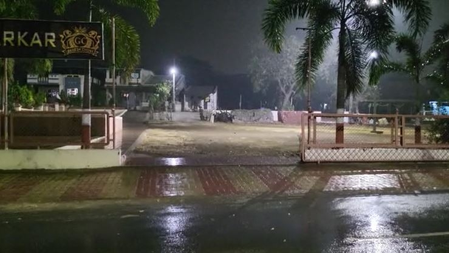
Ahmedabad, June 26 (IANS) Gujarat witnessed widespread rainfall across the state on Thursday, bringing much-needed relief from the recent spell of heat. According to data released by the State Emergency Operation Centre (SEOC), rainfall was recorded in 144 talukas between 6:00 am and 4:00 pm on June 26.
The heaviest rainfall was reported from Maliya Hatina in Junagadh district, where 5.16 inches of rain was recorded in just 10 hours. Other regions also experienced significant downpours, including Mahuva in Surat (4.76 inches), Visavadar in Junagadh (4.65 inches), Chikhli in Navsari (4.2 inches), and Khergam (4.17 inches).
In Gir Somnath’s Talala, 3.9 inches were recorded, followed by Bardoli in Surat (3.46 inches), Ranavav in Porbandar (3.03 inches) and Kamrej in Surat (3.03 inches). The rain activity was not limited to South Gujarat. Parts of Devbhoomi Dwarka, Valsad, Jamnagar, and Navsari also received moderate to heavy rainfall.
Notably, Kalyanpur and Pardi each recorded 2.87 inches, Mangrol 2.64 inches, Surat city 2.76 inches, Gandevi 2.64 inches, and Jam Jodhpur 2.56 inches. Navsari city received 2.7 inches of rain, further confirming the widespread reach of the first wave of monsoon.
In total, more than 2 inches of rain were recorded in 16 talukas, while another 13 talukas saw over 1 inch, making it a wet start to Ashadh for most regions in Gujarat.
Meanwhile, the India Meteorological Department (IMD) has issued a red alert for eight districts — Banaskantha, Patan, Surendranagar, Rajkot, Jamnagar, Devbhoomi Dwarka, Porbandar, and Morbi.
The warning comes under the department’s Nowcast system and is intended to alert local authorities and residents about the possibility of intense rainfall and adverse weather conditions in these areas.
In response to the widespread rainfall and the red alert issued for eight districts, the Gujarat government has activated its disaster response mechanism to ensure public safety and minimise disruptions.
The State Emergency Operation Centre (SEOC) is closely monitoring rainfall data and coordinating with local administrations in affected districts.
National Disaster Response Force (NDRF) and State Disaster Response Force (SDRF) teams have been kept on standby, especially in low-lying and flood-prone areas.
Control rooms have been set up, and emergency helplines have been activated across districts like Rajkot, Jamnagar, and Banaskantha.
The government has also instructed municipal bodies to clear clogged drains, ensure uninterrupted electricity supply, and provide shelter to affected families if needed.
–IANS
janvi/dan
